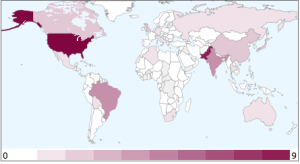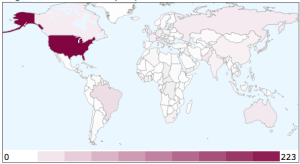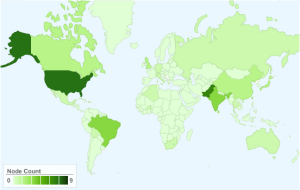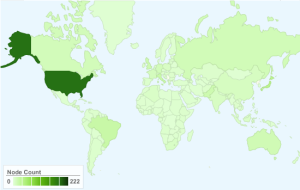Introduction
The PingER Node Count Intensity Maps and GeoMaps present a heat map of the number of PingER nodes spread over the world. These charts were generated using the information maintained by the PingER database. The same information may be viewed in the form of an overlay over Google Maps.
The charts were generated using the Google Visualization API for Intensity Maps and the GeoMaps.
An example of the charts is shown below:
PingER Monitoring Node Count |
PingER Monitoring Node Count |
PingER Node Count |
|---|---|---|
|
|
|
|
|
|
Interpretation
The numerical values labeling each chart (shown at the bottom) define the minimum (left) and the maximum (right) number of nodes that a country may host. Details of the monitoring sites may also be obtained from here. The magnified versions of the map presents the same information by zooming-in over regions (as defined by the Google Visualization API).
Implementation Details
HTML output
To create the intensity maps, the data must be loaded in a data structure (as explained by the Google Visualization API and) shown below:
<html>
<head>
<script type="text/javascript" src="http://www.google.com/jsapi"></script>
<script type="text/javascript">
google.load("visualization", "1", {packages:["intensitymap"]});
google.setOnLoadCallback(drawChart);
function drawChart() {
var data = new google.visualization.DataTable();
data.addColumn('string', '', 'Country');
data.addColumn('number', 'Node Count', 'a')
data.addRows(3);
data.setValue(0, 0, "UY");
data.setValue(0, 1, 0);
data.setValue(1, 0, "US");
data.setValue(1, 1, 9);
data.setValue(2, 0, "GB");
data.setValue(2, 1, 2);
var chart = new google.visualization.IntensityMap(document.getElementById('chart_div'));
chart.draw(data, {});
}
</script>
</head>
<body>
<div id="chart_div"></div>
</body>
</html>
The data must comply with the formatting requirements (as stated by Google Visualization API and copied below):
- The first column should be a string, and contain country ISO 3166-1-alpha-2 codes.
- Any number of columns can follow, all must be numeric.
Relevant files
Following are the files involved in the process of generating the HTML page:
Application:
File path for intensity maps: /afs/slac/package/pinger/intensity-map/create-pinger-node-count-intensity-map.pl File path for geo maps: /afs/slac/package/pinger/geomap/create-pinger-node-count-geomap.pl
The ISO 3166-1-alpha-2 codes are stored locally at:
File path: /afs/slac/package/pinger/intensity-map/country-codes.csv File format: #Country,code Pakistan, PK Korea Rep, KR United States,US
The PingER database file listing the up-to-date statistics for the monitoring nodes is located at:
File path: /afs/slac/package/pinger/nodes.cf
Example entry:
...
"ns.bnl.gov" => [
"130.199.128.14",
"bnl.gov",
"GOV.BNL.N2",
"Brookhaven National Laboratory",
"Upton, NY",
"United States",
"North America",
"40.76 -72.90",
"D",
"NOT-SET",
"NOT-SET",
"NOT-SET",
"",
"",
"IUPAP PPDG ",
"ccjsun.riken.go.jp "
],
...
Implementation
Following is the pseudo code for the implementation:
1. Load the country codes to a hash-map '%countryCodes', using the country names as the index.
Here the country names must be compatible with PingER defined country names.
2. Traverse through the countries of the PingER database and count the number of monitoring
nodes for each country. Note from the schema above that the country name is the defined in
the sixth column of each tuple. Also note that the status (monitoring, remote or deleted etc)
is defined in column nine.
3. Compile a list of country names available in the PingER database. Ensure that the list contains
unique names.
4. Generate the HTML output while considering the contraints defined by the Google Visualization
API.
a) Generate javascript defining charts for the World, Africa, Asia, Middle East and South America.
Generating up-to-date charts
To generate up-to-date charts with default options, simply execute the application:
/afs/slac/package/pinger/intesity-map/create-pinger-node-count-intensity-map.pl and /afs/slac/package/pinger/geomap/create-pinger-node-count-geomap.pl
Consequently the HTML output will be generated. The default output path is:
File paths: /afs/slac/g/www/www-iepm/pinger/pinger-node-count-intensity-map.html and /afs/slac/g/www/www-iepm/pinger/geomaps/pinger-node-count-geomap.html
To generate up-to-date charts for monitoring nodes only, execute the application with the following options:
/afs/slac/package/pinger/intesity-map/create-pinger-node-count-intensity-map.pl -r M
-o /afs/slac/g/www/www-iepm/pinger/pinger-mon-node-count-intensity-map.html
OR
/afs/slac/package/pinger/geomap/create-pinger-node-count-geomap.pl -r M
-o /afs/slac/g/www/www-iepm/pinger/geomaps/pinger-mon-node-count-geomap.html
Consequently the HTML output will be generated. The output path in this case would be:
File path: /afs/slac/g/www/www-iepm/pinger/pinger-mon-node-count-intensity-map.html OR /afs/slac/g/www/www-iepm/pinger/geomaps/pinger-mon-node-count-geomap.html
To obtain usage details set the help option while executing the application:
/afs/slac/package/pinger/intesity-map/create-pinger-node-count-intensity-map.pl -h OR /afs/slac/g/www/www-iepm/pinger/geomaps/pinger-mon-node-count-geomap.html --help
Miscellaneous Details
Authors: Umar Kalim & Les Cottrell 11/03/2008, version 1.0, Last revised on 11/10/2008. Idea champion: Shahryar Khan.





